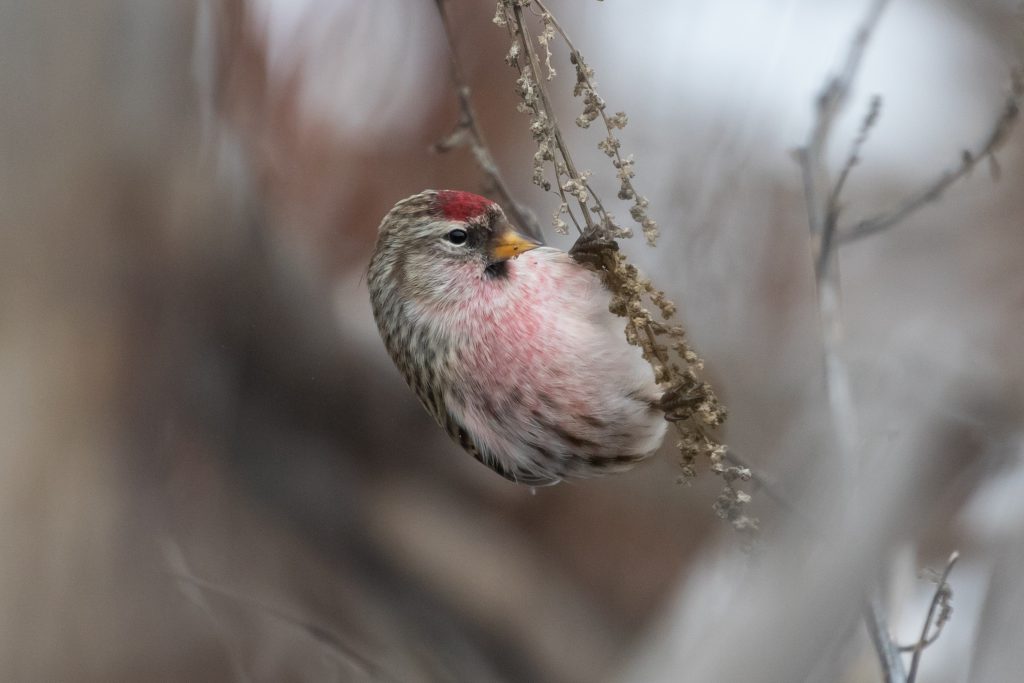Q+A With Tyler Hoar, Compiler of the Winter Finch Forecast

Each year, birders’ winter birdwatching plans hinge on a blog post: the annual Winter Finch Forecast. Each Winter Finch Forecast predicts the movement of the boreal finch species: Purple Finches, Pine Siskins, Evening Grosbeaks, Pine Grosbeaks, Red Crossbills, White-Winged Crossbills, Common Redpolls, and Hoary Redpolls. It also predicts the movement of three non-finch passerines with finch-like behaviors: Red-Breasted Nuthatches, Blue Jays, and Bohemian Waxwings.
Ron Pittaway formally kicked off the forecast in 1999 following several years of informal forecasts. But in 2020 he stepped down, and Ontario birder Tyler Hoar took his place. Based on the state of the available food, Tyler predicted that the winter of 2020-2021 would be an irruption year, where finches leave the boreal forest—and indeed, last winter marked a “superflight” year, with boreal finches appearing across the United States outside of their typical habitats.
I caught up with Tyler to ask him a bit about winter finches and what it’s like putting together the forecast. Stay tuned for this year’s forecast, scheduled to come out on September 26!
This interview has been condensed and lightly edited for clarity.
What’s your background? How did you get into predicting finch movements?

I’ve been a biologist for 20+ years, working throughout the boreal forest and Canada. I have a good working relationship with Ron Pittaway and have been looking at cones for quite some time. I also work well with Matt Young and the other finch junkies across the boreal in order to form a nice picture of the network of people available to help put together this effort. I also like talking to Ron and building the forecast with the help of his experience.
How do you put together the Winter Finch Forecast?
Each year, I send out requests across North America to all of the contacts that Ron Pittaway previously developed, and new contacts I have developed to give us a list of cone- and fruit-bearing trees, and then slowly consolidate their replies as they come in—and chase down people who I don’t hear back from. Then, I look at the big picture for each tree species. Are the results part of a larger story, or are there just small pockets of fruits and seeds? Finally, I synthesize the data to predict the bird movements, review the results with a few people, and put it out to the world—and hope that the birds cooperate.
Why is it important to understand the trees to understand finch movements?
Moving is more a survival thing for finches than it is for neotropical migrants. Most of the finches are primarily boreal forest feeders, while the redpolls like weedy fields as well. If a location doesn’t have a good cone crop, then the finches won’t stay there—they’ll fly further south looking for cones or for suitable bird feeders. Years where we have a heavy cone crop across the boreal forests, the birds don’t have to really move because they have lots of food to get through the cold winter—they don’t want to move if they don’t have to. If there’s food, they won’t move. If there’s no food, they move.
What makes boreal finches difficult to study?
Studying these birds can be a huge challenge. Before Covid, you had a lot more travel to these areas as outdoorsmen, first nations people, and researchers were traveling around the boreal forest and providing more information. But since Covid, a lot of people aren’t going to some of these areas. Huge tracts of the boreal forests are question marks. You try to get the best pictures you can from adjacent areas to see what’s going on using the data you have. You have some bird movement tracking on eBird which helps you figure out what the crossbills are going to do. Plus, you can look at weather maps for droughts and forest fires to figure out what’s going on there. For example, in Northwestern Ontario where we don’t have a lot of observers, we had a really bad drought and one of the worst forest fires in decades. We knew there wouldn’t be a great crop up there since the trees are all stressed.

How do you collect information to put together the forecast?
I send volunteers a form with the main boreal tree species as well as some berry trees as well as oaks and maples. The form has a system where they rank the cone or fruit crop of each tree with poor, fair, excellent, good, and bumper. Last year we also had a “none” added in addition to poor. Some of the volunteers will distill all of their details into those one word answers, but others will also send me great descriptive thoughts about how the crop looks and varies in different places. One volunteer this year explained that the crop was better on the river than the uplands. Those with a scientific background might also offer quantitative data on the size of the crop.
What do you enjoy about putting together the forecast?
I love to see the interaction—the big landscape ecology—between the weather, the trees, and the birds, and trying to figure out the puzzle of what they’re going to do, then see if they’re following the predictions or not. Every year something might happen that throws things off—that’s why it’s a forecast, not the law. For example, I did think that the birds were going to move last year, but I didn’t think they were going to do something they hadn’t done in forty years and leave Canada as fast as they did.
What are some of the biggest challenges about putting it together?
The biggest challenge is just following up with all of the volunteers, especially the ones who don’t reply at all—chasing them down without ruffling any feathers. I need to have all of the information ready by a deadline so that I have time to put everything together.
How do you think you’ve done so far?
Well, last year, the birds came, which people were very happy with. There were a couple of surprises—the Pine Siskins were hiding in the Quebec spruce budworm outbreak and showed up in larger numbers further south than we had expected. For me personally, if the birds exceed my expectations, that’s great. If they don’t meet my expectations in the post, then that’s bad.
Any advice for folks who want to get involved?
I’d happily take any volunteers if they can tell the difference between tree species and want to supply information. The more different voices I have and different skill levels participating helps provide a more rounded picture in each area. I love areas where I have multiple observers covering a general area, places like Northern Minnesota. Sometimes on the microscale, things look really different but together it tells me a bigger story about what the cone and fruit crop looks like. This year the Finches, Irruptions, and Mast Crops facebook group also introduced me to some volunteers. Again, being able to tell the difference between the trees is very helpful.
Stay tuned for Tyler’s 2021-2022 Winter Finch Forecast!
The Finch Research Network (FiRN) would like to keep everyone up to date on the latest research and blogs that we post every couple weeks, and so please consider signing up to be reminded when we’ve posted new information: https://finchnetwork.org/subscribe
We can also be followed on FB and Instagram @thefinchmasters:
